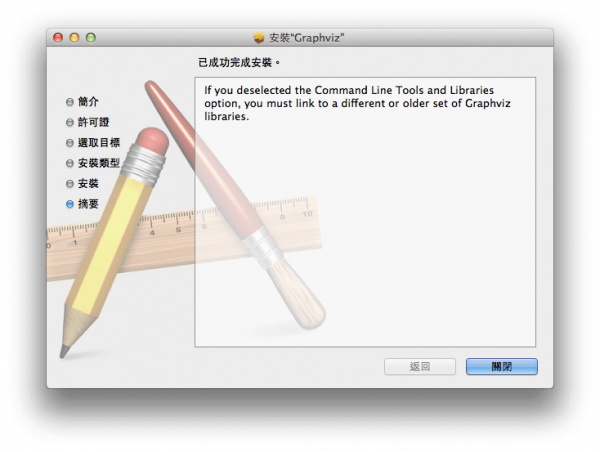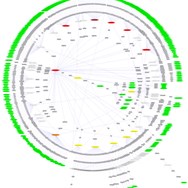

- Osx graphviz how to#
- Osx graphviz pdf#
- Osx graphviz install#
- Osx graphviz code#
- Osx graphviz windows#
Osx graphviz install#
$ make $ make install What did we getĪfter all that, what have we got? The make install will place all of the Graphviz executables in /usr/local/bin, the most commonly used Graphviz command is dot. The compiler will show lots of warnings which can be ignored, and hopefully no errors. configure -with-quartzįinally, we can now build and install the Graphviz binaries. If you do need to install additional libraries and tools, run the configure script after to pick up any changes. I’m not going to cover the specifics here, if you don’t have a language already installed you probably don’t need the Graphviz extensions. The extensions that get built will depend on the languages installed on your system. There are also bunch of optional language extensions. Just one plugin left to figure out here for ghostscript.

Osx graphviz windows#
There are also a number of optional plugins enabled plugin libraries: dot_layout: Yes (always enabled) neato_layout: Yes (always enabled) core: Yes (always enabled) devil: Yes gd: Yes gdiplus: No (disabled by default - Windows only) gdk: Yes gdk_pixbuf: Yes ghostscript: No (missing Xrender) glitz: No (disabled by default - incomplete) gtk: Yes lasi: Yes ming: No (disabled by default - incomplete) pangocairo: Yes poppler: Yes quartz: Yes rsvg: Yes visio: Yes webp: Yes xlib: Yes
Osx graphviz how to#
I’ve not figured out how to successfully build with the required OpenGL dependencies, so we’ll skip it for now.

Running the autogen.sh can take a few minutes, once complete you should see a summary of the enabled component, like this: graphviz-2.42.0 will be compiled with the following: options: cgraph: Yes (always enabled) digcola: Yes expat: Yes fontconfig: Yes freetype: Yes glut: Yes ann: No (no ann.pc found) gts: Yes ipsepcola: Yes ltdl: Yes ortho: Yes sfdp: Yes swig: Yes ( 4.0.1 ) shared: Yes static: No (disabled by default) qt: Yes x: Yes commands: dot: Yes (always enabled) neato: Yes (always enabled) fdp: Yes (always enabled) circo: Yes (always enabled) twopi: Yes (always enabled) gvpr: Yes (always enabled) gvmap: Yes (always enabled) lefty: Yes smyrna: No (requires: gtk+ gtkglext glade) gvedit: YesĪ couple of options that are not enable yet are ann and smyrna. The environment variables are required to pickup some of the libraries that Homebrew installs as “keg-only”. Run the build configuration $ export CXXFLAGS=-std=c++11 $ export PATH="/usr/local/opt/qt/bin:$PATH" $ export PKG_CONFIG_PATH="/usr/local/opt/libffi/lib/pkgconfig:/usr/local/opt/qt/lib/pkgconfig:/opt/X11/lib/pkgconfig" $ export LDFLAGS="-L/usr/local/opt/libffi/lib" $. This is currently stable_release_2.44.0 $ git clone $ cd graphviz # find the latest stable version $ git tag | grep stable | sort | tail -n 1 stable_release_2.44.0 $ git checkout stable_release_2.44.0
Osx graphviz code#
Get the latest Graphviz source code from and change to the stable branch. Now we need to ensure we have all the required tools and library dependencies, these are installed using Homebrew with: $ brew install autoconf autogen automake $ brew install cairo pango gts gd librsvg libffi swig freeglut $ brew install lasi poppler devil gtk $ brew cask install xquartz The following steps have been tested to build graphviz version 2.42.0 (20190704.1412) on MacOX Mojave 10.14.5įirst, if you have previously installed Graphviz using Homebrew, uninstall it $ brew uninstall graphviz So to get Graphviz installed with any optional extras we now have to resort to building and installing from source. Install options where removed from Homebrew - see Remove all options from Homebrew/homebrew-core formulae #31510 as to why.
Osx graphviz pdf#
If you search around for information on enabling PDF support you’ll find answers that suggest using the following Homebrew installation options: $ brew install graphviz -with-pango -with-cairoīut, since Januthis approach no longer works. The current Homebrew formula excludes some of these optional capabilities, including PDF support. Graphviz can be built with several optional capabilities and plugins depending on the build flags and the libraries available on the system at build time. However, at the time of writing, the brewed version of Graphviz 2.40.1_1 has some limitations.

GraphViz is available as a Homebrew package which can be installed as simply as: $ brew install graphviz For general usage installing GraphViz on MacOS is fairly straightforward.


 0 kommentar(er)
0 kommentar(er)
